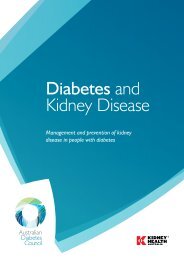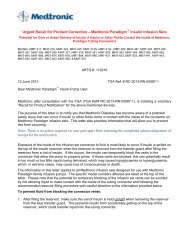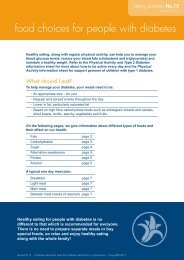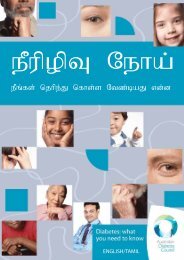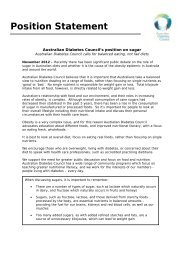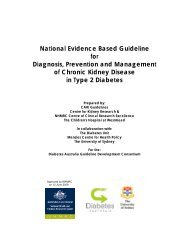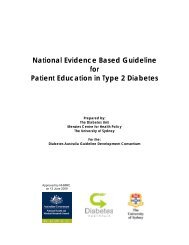O MeA e tAtAU OnA e IlOA - Australian Diabetes Council
O MeA e tAtAU OnA e IlOA - Australian Diabetes Council
O MeA e tAtAU OnA e IlOA - Australian Diabetes Council
You also want an ePaper? Increase the reach of your titles
YUMPU automatically turns print PDFs into web optimized ePapers that Google loves.
What’s in food? - continued<br />
Not all low glycemic index foods are healthy. You still need to consider if the food fits into the<br />
healthy eating recommendations listed earlier. Try to eat mostly high fibre low fat and lower<br />
glycemic index foods. Including a lower glycemic index food at every meal is a good start.<br />
Some healthy lower glycemic index foods include pasta, legumes (dried beans and lentils),<br />
sweet corn, kumara, taro, cassava, low fat milk and yoghurt, most fruit and many high fibre<br />
grainy breads.<br />
Rice is usually a high glycemic index food. However, there are some varieties of rice that have<br />
a lower glycemic index. These include Basmati rice and Doongara rice.<br />
What about sugar?<br />
Sugar is also a carbohydrate. Eating small amounts of sugar will not affect your diabetes, e.g.<br />
1 teaspoon of sugar in your cup of tea or a thin spread of jam on your toast.<br />
Some foods that contain sugar are also healthy foods. For example fruit and milk naturally<br />
contain sugar. Other healthy foods have had small amounts of sugar added to them (e.g.<br />
some high fibre breakfast cereals and yoghurts). We know these foods are good for us so we<br />
can include them in our diet.<br />
However eating or drinking large amounts of foods that are very high in sugar (e.g. soft<br />
drinks, cordials, fruit juices, flavoured milk and drinks made up with sweetened condensed<br />
milk) can cause your blood glucose levels to rise too high. They can also cause you to put on<br />
weight. These foods are best eaten in small amounts. Choose diet soft drinks and cordials<br />
instead of standard varieties. Sweetened condensed milk is high in sugar and fat. The<br />
healthier alternative is to use skim milk with 1-2 teaspoons of sugar or a sweetener (such as<br />
Equal, Splenda and Sugarine ).<br />
If you are using sugar in recipes, think about how much sugar you will end up eating. If the<br />
recipe is very high in sugar and you will be having a large serve, try reducing the amount of<br />
sugar, have a smaller serve or replace some of the sugar with an alternative sweetener (such<br />
as Equal, Splenda and Sugarine ). Try to choose recipes that are low in fat (particularly<br />
saturated fat) and contain some fiber.<br />
Fibre<br />
Fibre is important for everyone, including people with diabetes. Fibre can help keep your<br />
digestive system healthy and prevent constipation.<br />
Fibre is also very useful for people with diabetes. It can help to lower “bad” cholesterol which<br />
helps to keep your heart healthy. Also many foods that are high in fibre have a low glycemic<br />
index. This is because some types of fibre can slow down digestion of the food. Eating foods<br />
high in fibre can also keep you feeling fuller for longer so may help with weight control.<br />
High fibre foods include whole fruits (not juice) (e.g. paw paw), vegetables (e.g. cassava and<br />
taro), legumes, nuts and seeds, grainy and wholemeal breads and high fibre cereals.<br />
30




